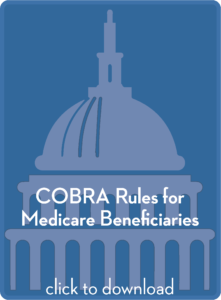Contents
House Republicans Withdraw the AHCA Before A Planned Vote But Efforts to Repeal Continue
-
COBRA Rules for Medicare Beneficiaries
Federal Employment Laws by Employer Size
Report to Congress Annual Report on Self-Insured Group Health Plans
2016 Health Plan Design Benchmark Summary
Did you know? HHS Extends Transition policy
House Republicans Withdraw the AHCA Before A Planned Vote But Efforts to Repeal Continue
by Marathas Barrow Weatherhead Lent LLP
On Friday, March 24, 2017, the U.S. House of Representatives’ Speaker Paul Ryan pulled from the floor the American Health Care Act (AHCA), the proposed legislation to repeal and replace the Affordable Care Act (ACA), once it was clear that the bill was short on votes to pass. Effectively, this means the AHCA will not survive to become law and, at this time, any future efforts to repeal and replace the ACA are uncertain. This may mean, as Speaker Ryan said shortly after the announcement that the bill was withdrawn, “Obamacare is the law of the land. We’re going to be living with Obamacare for the foreseeable future.” However, as of March 28, there have been reports that the House Republican leaders and the Trump administration have started renegotiations on legislation to repeal the ACA. At this time, there are no details about what may be in any renewed repeal legislation or the timing of its release or a vote.
What the AHCA Would Have Done
If enacted, the AHCA would have retroactively repealed the individual and employer mandate penalties, delayed the 40% “Cadillac” tax on employer-sponsored health plans, made significant changes to the ACA insurance coverage and marketplace stabilization provisions, enhanced health savings accounts (HSAs), provided relief from many of the ACA’s taxes and fees, and curtailed Medicaid reforms, among other things.
The AHCA was intended to be Phase I of a three-phase approach to repeal and replace the ACA through the budget reconciliation process, which requires a simple majority vote in Congress. Phase II was envisioned to include regulatory relief by Health and Human Services (HHS) Secretary Thomas Price, and in Phase III legislation would be introduced to repeal the ACA market reforms, permit the sale of insurance across state lines, and effectuate other provisions that could not be addressed through the budget reconciliation process because of the Byrd rule, which limits reconciliation provisions in the Senate to provisions that affect government revenues and outlays.
Why it Failed
In large part, the bill failed because the more conservative wing of the Republican Party, known as the Freedom Caucus, was against the bill because of its preservation of certain ACA provisions. Prior to the vote on the bill, which was initially scheduled for Thursday, changes were introduced (via what was referred to as the “Manager’s Amendment”) to add concessions (such as accelerating the repeal of most of the ACA tax provisions) in the hope that the Freedom Caucus, representing more than 30 members, would vote in favor of the bill. However, when realizing that even those concessions were not enough, additional concessions, including the repeal of the federal “essential health benefits” definition were added. At that point, more moderate Republicans were voicing concerns. Late Thursday, President Trump issued an ultimatum, demanding a vote on Friday and threatening Republicans that the ACA would remain the law if Republicans did not back the AHCA. By Friday afternoon, it was apparent that a compromise could not be reached, and the bill was withdrawn (at President Trump’s request) without going to a vote.
What Does This Mean for Employers
Effectively, at least for the short term, the ACA, including the employer and individual mandates (including associated reporting) remains the law of the land. Until further notice, employers must stay the course on their compliance efforts.
Administrative Relief May Be Forthcoming
Consistent with the President’s Executive Order issued immediately after his taking office, there may be pressure on HHS Secretary Price in the short-term to provide regulatory relief to the extent permitted by the ACA. However, it is unclear whether any such relief will focus on issues facing employer-sponsored group health plans.
Future Legislative Efforts Uncertain
President Trump could remain firm on his ultimatum and not support any future efforts to repeal the ACA and test his theory that it will “explode.” One way the Republicans may help hasten this is by choosing not to pursue a lawsuit filed by Congressional Republicans during the Obama administration that would de-fund the cost-sharing reduction subsidies paid to insurers to reduce out-of-pocket costs for low-income enrollees, which the Republicans have asserted are illegal. In that case, Republicans argued that Congress never actually gave the Obama administration funding for the program that’s being used to pay insurers. A district court judge decided in their favor, but the Obama administration appealed the case. The case was delayed in February and is currently on hold, with an update due in May. Many believe these payments are essential for the stability of the insurance market. It remains to be seen whether the administration will drop the case and Republicans will fund the next round of subsidies in the short-term spending bill due at the end of April in exchange for a commitment by insurance companies not to abandon the market over the next few weeks. Many conservatives may view this course of action as “giving up” on repeal and may not support it unless it is part of a larger repeal and replace effort.
Initially, the Trump administration and other Republican leadership stated that they intended to move on to tax reform and other initiatives at the top of the Trump administration’s agenda. However, there is nothing that could stop Republicans from trying to garner support for another repeal effort, and, in fact, there have been recent reports that the House Republicans and the Trump administration are back in negotiations on repeal legislation. The details and timing of such renewed efforts have yet to be released. It is possible that the Republicans may offer piecemeal legislation to address certain components of the ACA, rather than a complete repeal.
ACA Taxes Repeal May Be Left Out of Any Tax Reform
Taxes associated with the ACA will remain untouched while Congressional Republicans work on reforming the rest of the tax code, House Speaker Ryan said following the March 24 decision to pull the AHCA from a planned House vote. According to the latest Congressional Budget Office report, repeal of the ACA taxes would have reduced revenues by nearly $1 trillion over the next ten years. Republicans believed that repealing the ACA taxes first and being able to offset them with ACA spending cuts would have made tax reform easier. According to Ryan, failure to pass the AHCA “just means the Obamacare taxes stay with Obamacare. We’re going to go fix the rest of the tax code.”
ACA Taxes Repeal May be Funded by Cap on Employer Sponsored Health Coverage
However, ACA tax repeals may be part of the larger tax reform effort if other tax expenditures would be used to finance the repeal. One option that has been suggested is instituting a cap on the exclusion for employer-sponsored health coverage. Initial leaked drafts of the AHCA had included such a provision but were not included when the bill was introduced earlier this month after there was political pressure by employer groups to eliminate it.
While it is not quite clear yet that the dust has settled, employers should proceed with the expectation that the IRS will begin enforcing the employer mandate via the ACA reporting forms, and prepare for the return of the health insurance industry tax (HIT) in 2018 (the HIT affects fully-insured medical, dental and vision plans but was under a one-year moratorium for 2017). Lastly, the Cadillac tax is expected to be effective in 2020, so employers should also continue evaluating how their plans may be impacted. Of course, it’s certainly possible that the Cadillac tax will be delayed again in the future.

Health care costs continue to rise, which means employers need to take every opportunity to lower expenses. One strategy is to employ referenced-based pricing (RBP). RBP enables employers to set limits on certain medical services, shifting the cost-analysis burden onto employees.
How it Works
RBP works by setting spending limits on certain procedures or services—meaning an individual would only be covered up to the established limit for these services and would have to pay the cost difference out of pocket. However, limits should only be set on “shoppable” services. These are services where an individual can take time to make a decision based on price and quality, like for prescriptions, lab tests or joint replacements. In all of these examples, there are lower-cost options that are typically the same quality as the more expensive alternatives.
Employers typically work with a third-party vendor to establish the best limit for a procedure. The vendor will help conduct market research and negotiate the most appropriate deals with providers. Finding a reliable vendor that works well with your company is crucial for negotiating the best prices for your employees.
RBP is most effective when applied to procedures with fluctuating costs. For instance, colonoscopies may range from $400 to $6,000, depending on the physician. In this case, an employer using RBP might set the spending limit to the median price of the procedure, based on market findings. If an employee uses a health facility that charges above the spending limit for a specific procedure, he or she will need to cover the difference out of pocket.
Employer Value
Employers who use RBP have the potential for two main benefits: lower total health care expenses and higher employee engagement in health care decisions.
Health coverage usually extends to any in-network procedure, regardless of cost. With RBP, employers do not risk paying exorbitant prices for services that could be done more inexpensively. By setting a limit on certain procedures, employers are empowering employees to take charge of their health care decisions.
Having established limits on specific services means employees must consider cost, in addition to quality, when choosing where to have a procedure. This requires research on the employee’s part, encouraging active participation in his or her health care. It is estimated that low health literacy costs the United States $106 billion to $238 billion annually. By promoting employee engagement in health care decision-making, you are helping to educate employees, while lowering overall health costs.
Potential Cons
There are a number of considerations to make when implementing RBP, given the complexity of the model. It is paramount you work with a vendor who is reliable and experienced in the RBP process. The vendor must be able to ensure a smooth transition into this model, otherwise you risk disrupting highly utilized providers. If you choose a vendor who is inexperienced, your RBP limits might be too low for the services your employees need, making the plans unaffordable. Moreover, not using a vendor (and its legal advocacy) could potentially leave you vulnerable to providers attempting to balance bill.
Conclusion
RBP is an innovative strategy for lowering health care costs. As the market continues to evolve, employers are tasked with developing creative strategies for saving money. The RBP model is unique in its ability to reduce costs while simultaneously promoting employee health literacy.
To learn more about RBP, and to see if it is right for your organization, contact your HealthSure Insurance Services representative today.
COBRA Rules for Medicare Beneficiaries 
As older Americans—those who are age 65 and older—continue to stay in the workforce, employers will need to understand how an employee’s entitlement to Medicare impacts eligibility under the Consolidated Omnibus Budget Reconciliation Act (COBRA).
Federal Employment Laws by Employer Size

An employer’s size, or number of employees, is a key factor in determining which federal labor laws the employer must comply with. Some federal labor laws, such as the Equal Pay Act, apply to all employers, regardless of size. However, other laws, such as the Family and Medical Leave Act, only apply to employers that reach a certain employee count.
Employers should be aware of the federal labor laws that may apply to their company based on their size. This is especially important for employers that have fluctuating workforce numbers or that are considering hiring additional employees. In general, the more employees that an employer has, the more compliance obligations it will have under federal labor laws.
This Compliance Overview provides a guide of key federal labor laws that apply based on employer size. Most states also have their own labor and employment laws. This summary does not address state labor laws, and it also does not address additional compliance requirements for companies that contract with the federal government or businesses in specific industries.
Report to Congress Annual Report on Self-Insured Group Health Plans
The Secretary of Labor must provide an annual report to Congress, containing general information on self-insured employee health benefit plans. The data is gathered from groups’ submitted Form 5500s.
2016 Health Plan Design Benchmark Summary
The Health Plan Design Benchmark Summary is based on data gathered from the largest database in the country, consisting of nearly 60,000 employer-offered health plans. The data analyzed in this summary provides benchmarking information on six key plan design measures:
- Individual out-of-pocket maximum
- Individual deductible
- Emergency room copay
- Office visit copay
- Specialty office visit copay
- Prescription drug deductible
To help employers compare their plan design offerings against similar organizations and plans, the data is broken down by group size and plan type.
This is a summary document analyzing the data set as a whole and comparing it against previous years’ data. To view a report of how your specific plan design measures up in comparison to employers of your size, in your region or in your industry, contact your account manager.
In late February 2017, the Department of Health and Human Services (HHS) extended an existing transition policy for certain health plans that do not comply with the Affordable Care Act (ACA) for an additional year, to policy years beginning on or before Oct. 1, 2018.
During this transition period, health coverage in the individual or small group market that meets certain criteria will not be considered to be out of compliance with the ACA’s market reforms.
The extension means that individuals and small businesses may be able to keep their non-ACA compliant coverage through 2018, depending on the plan or policy year. If the ACA is repealed, replaced or amended, the market reforms may no longer apply to these plans.






